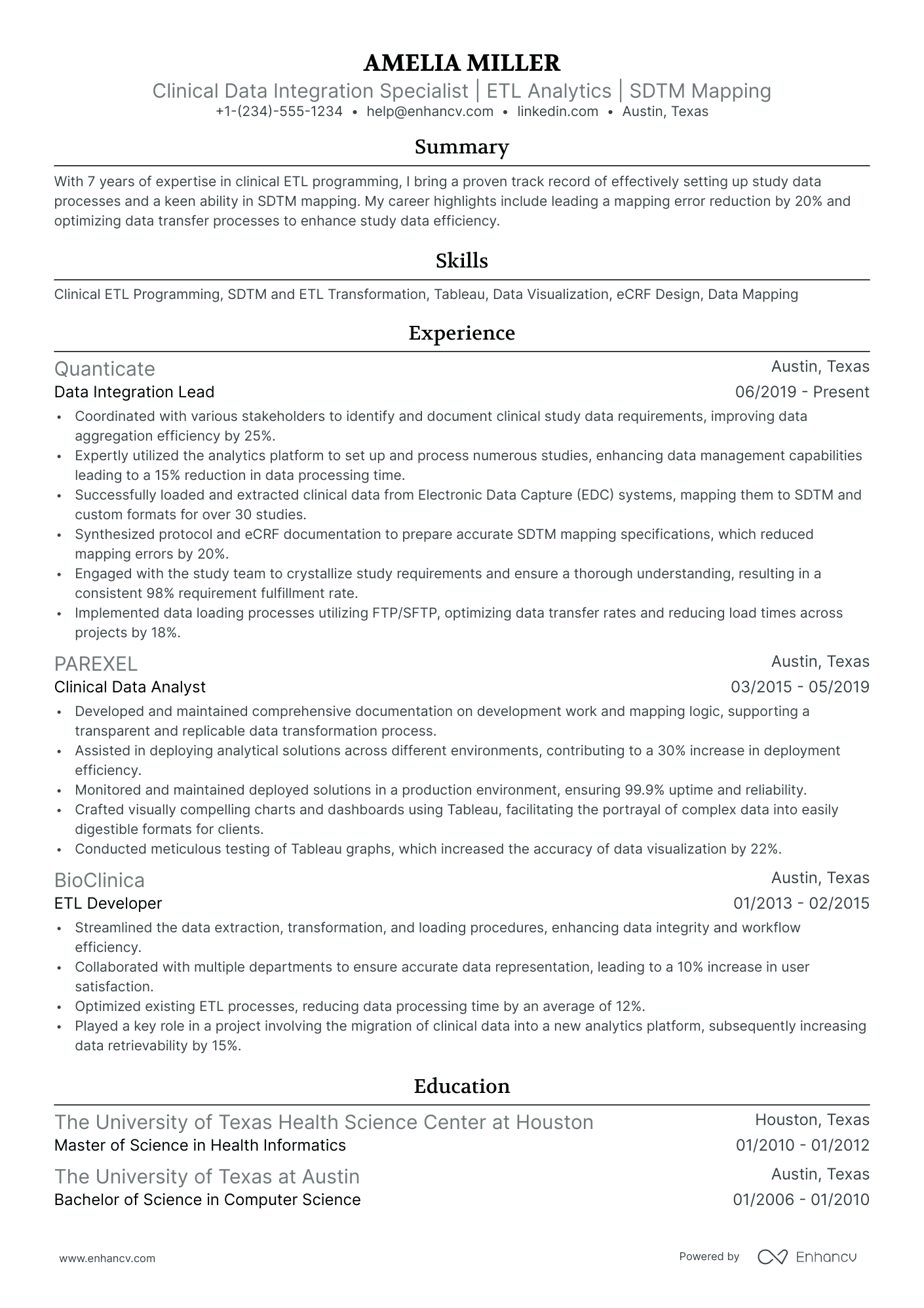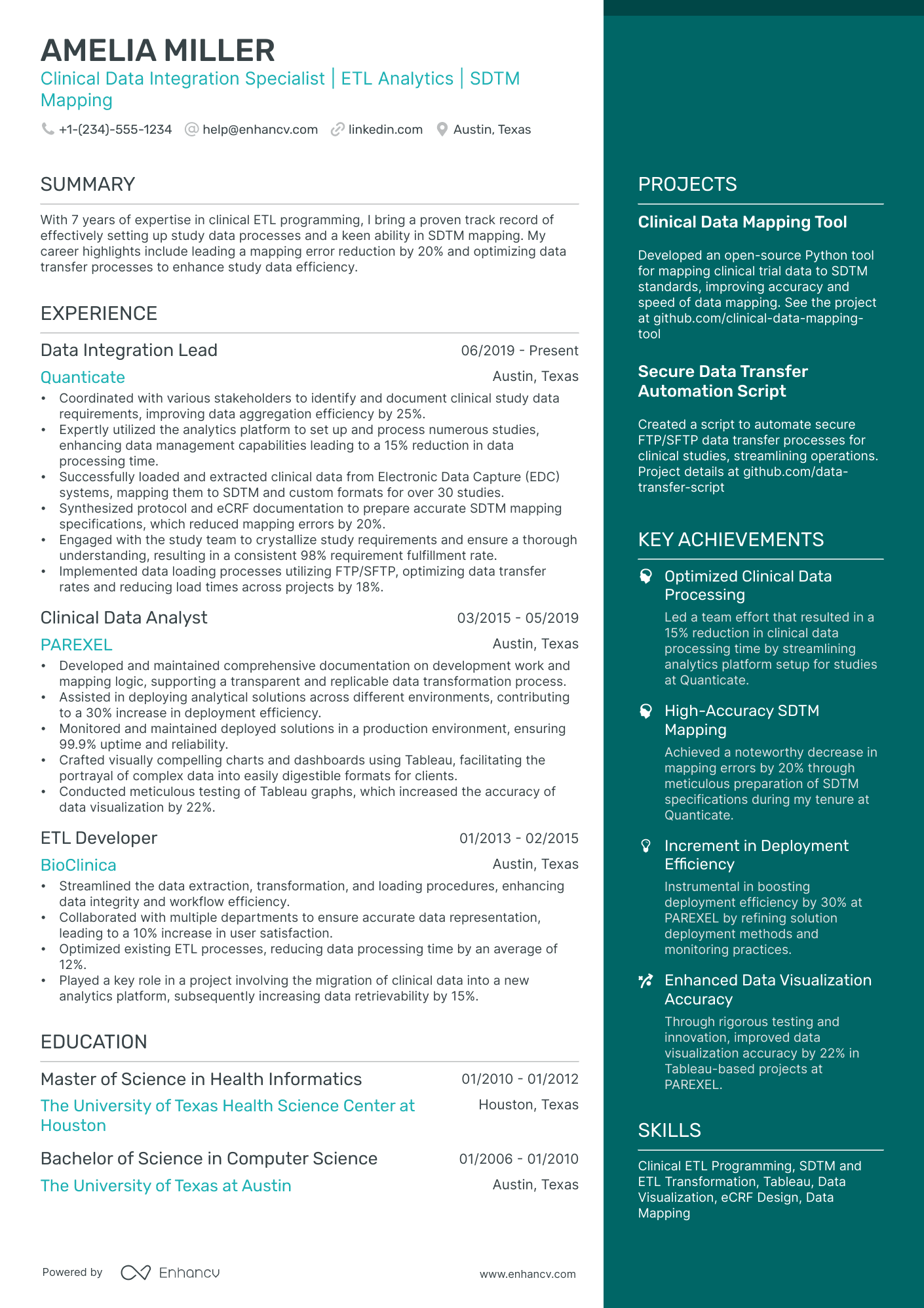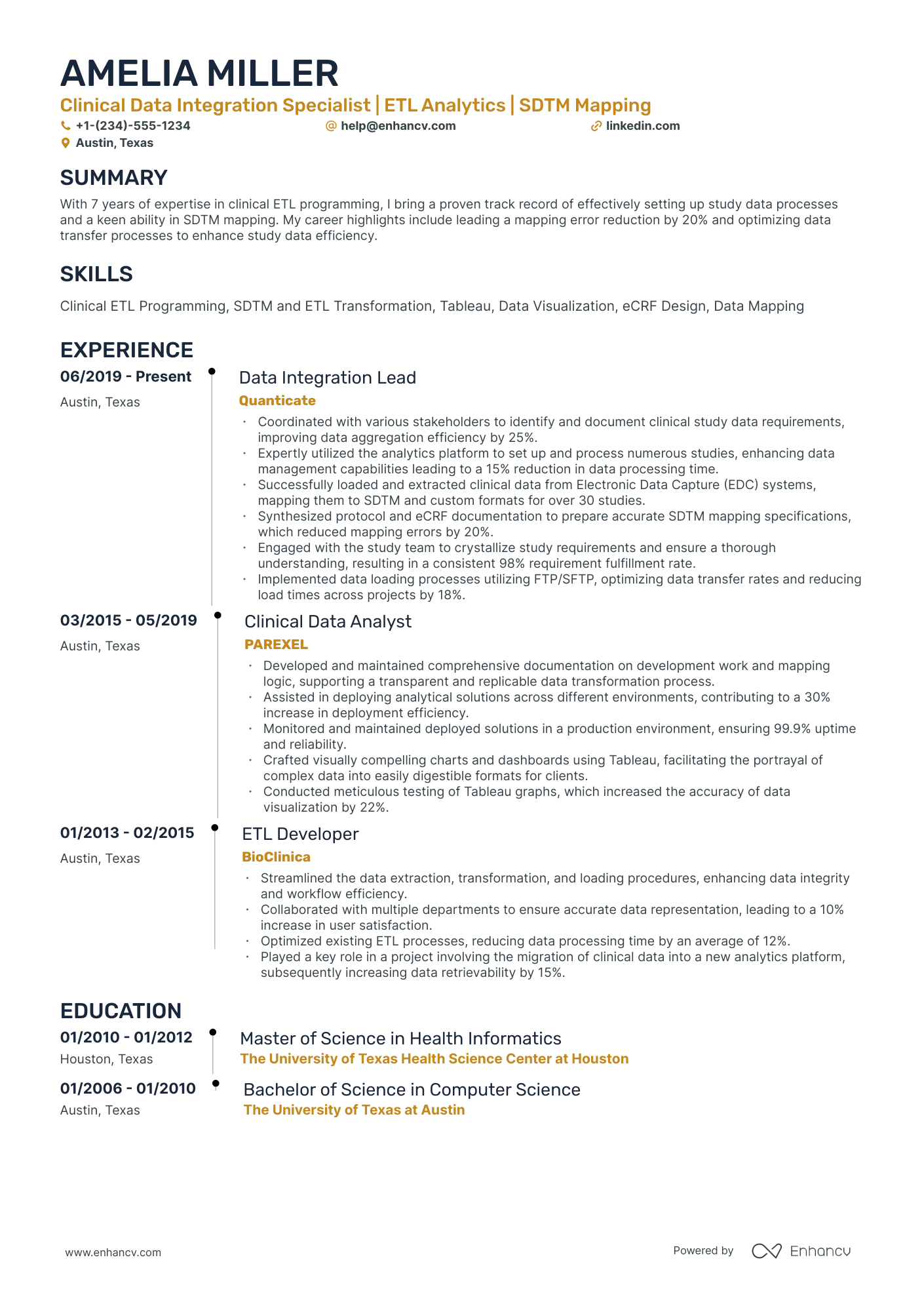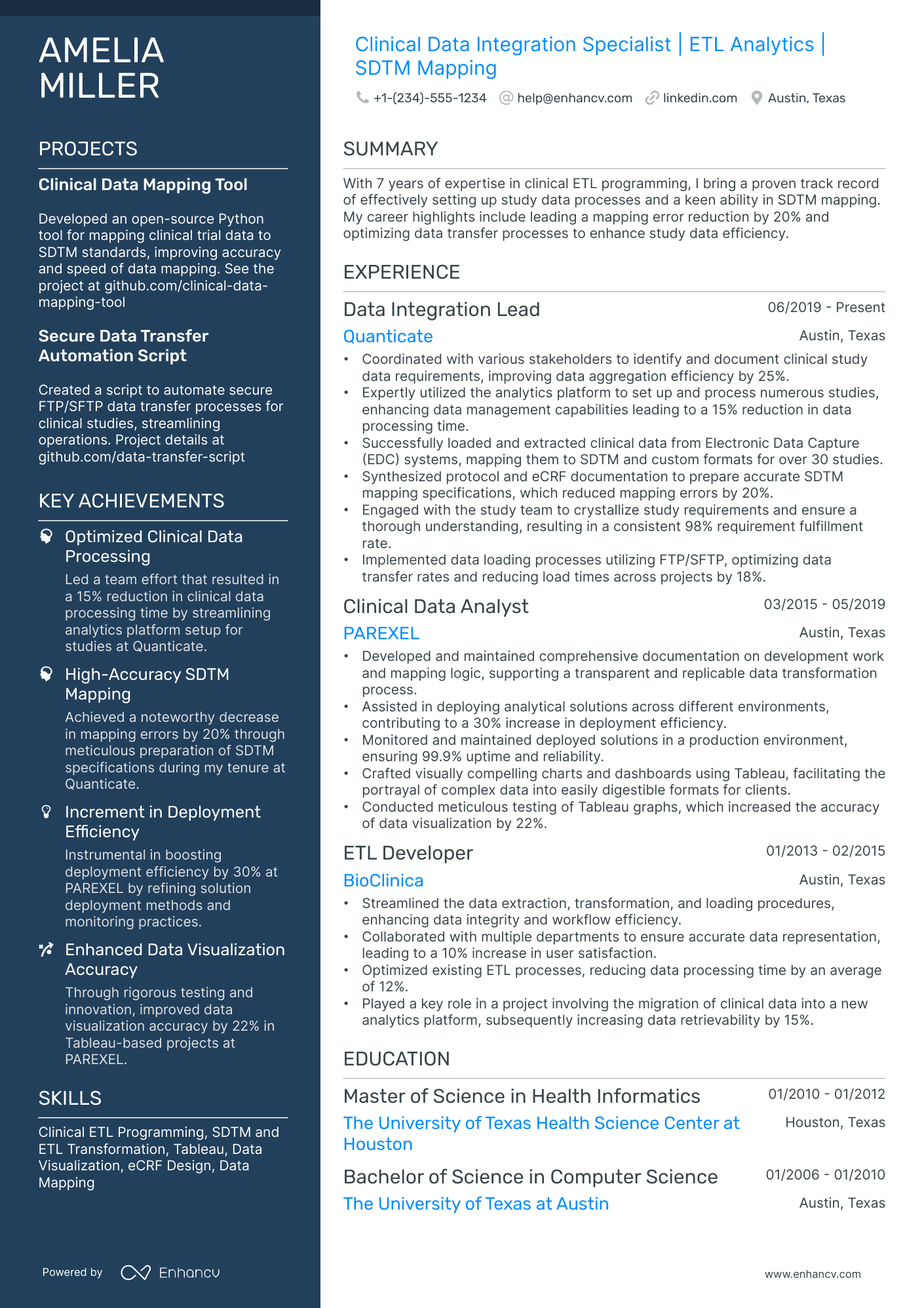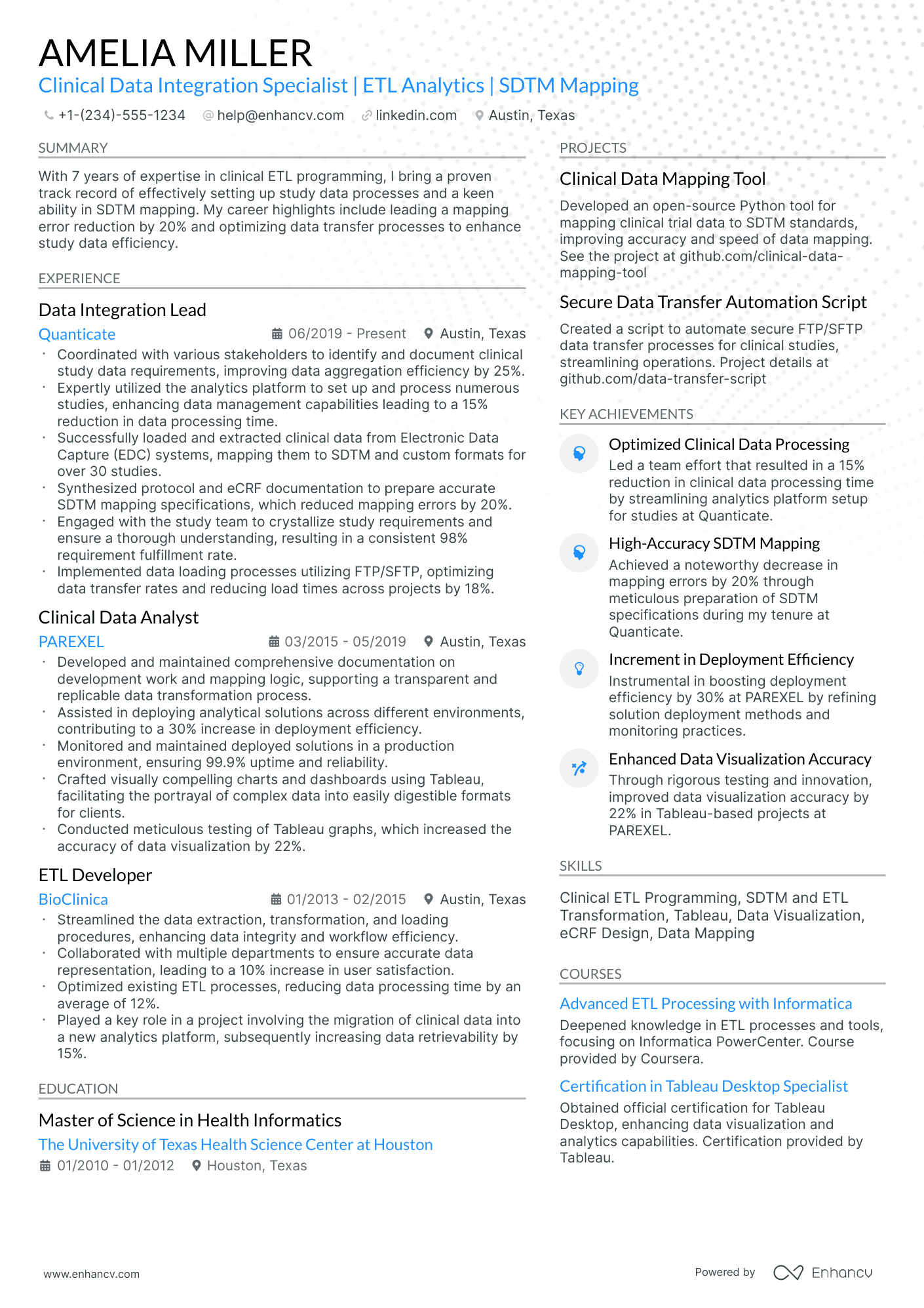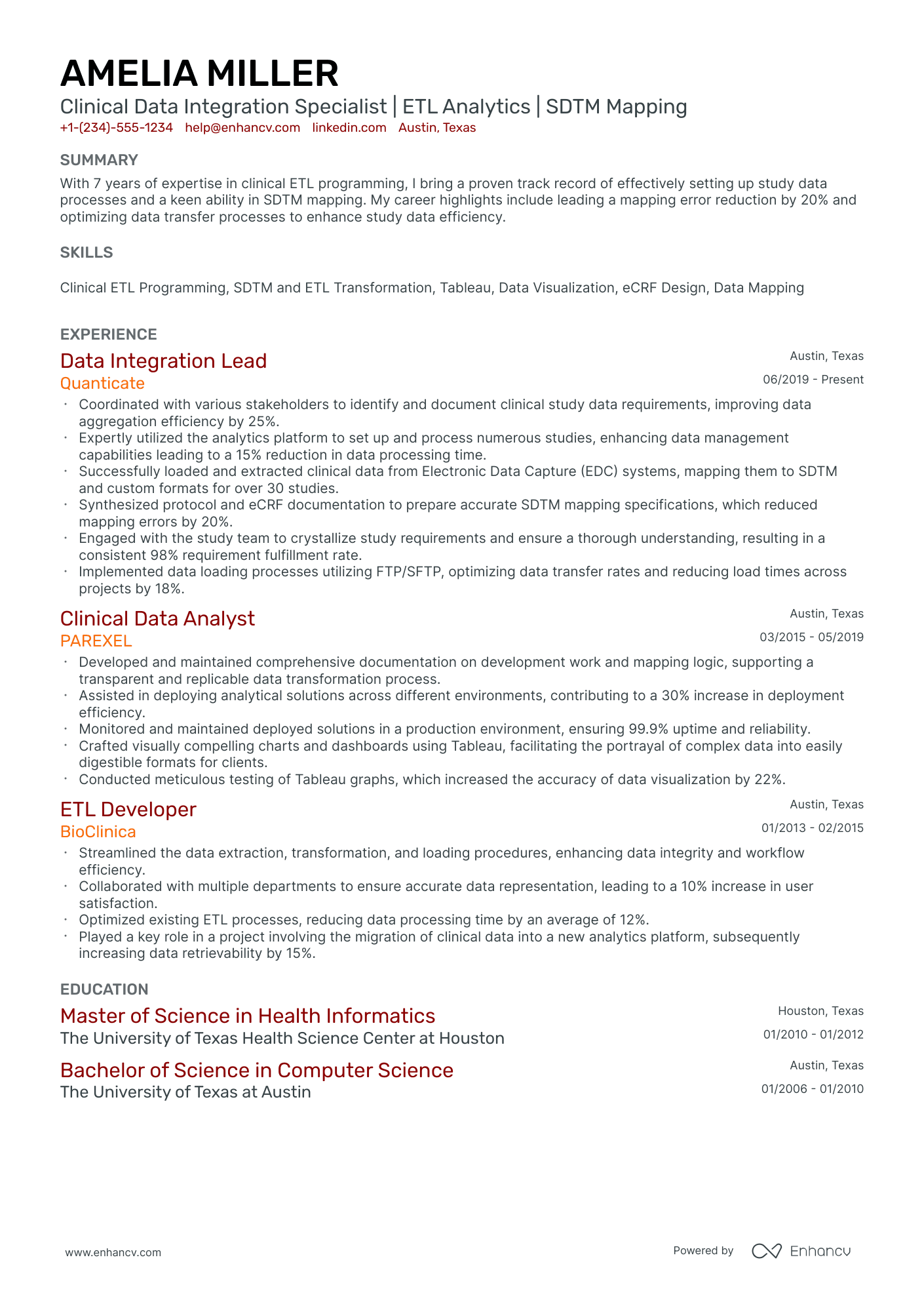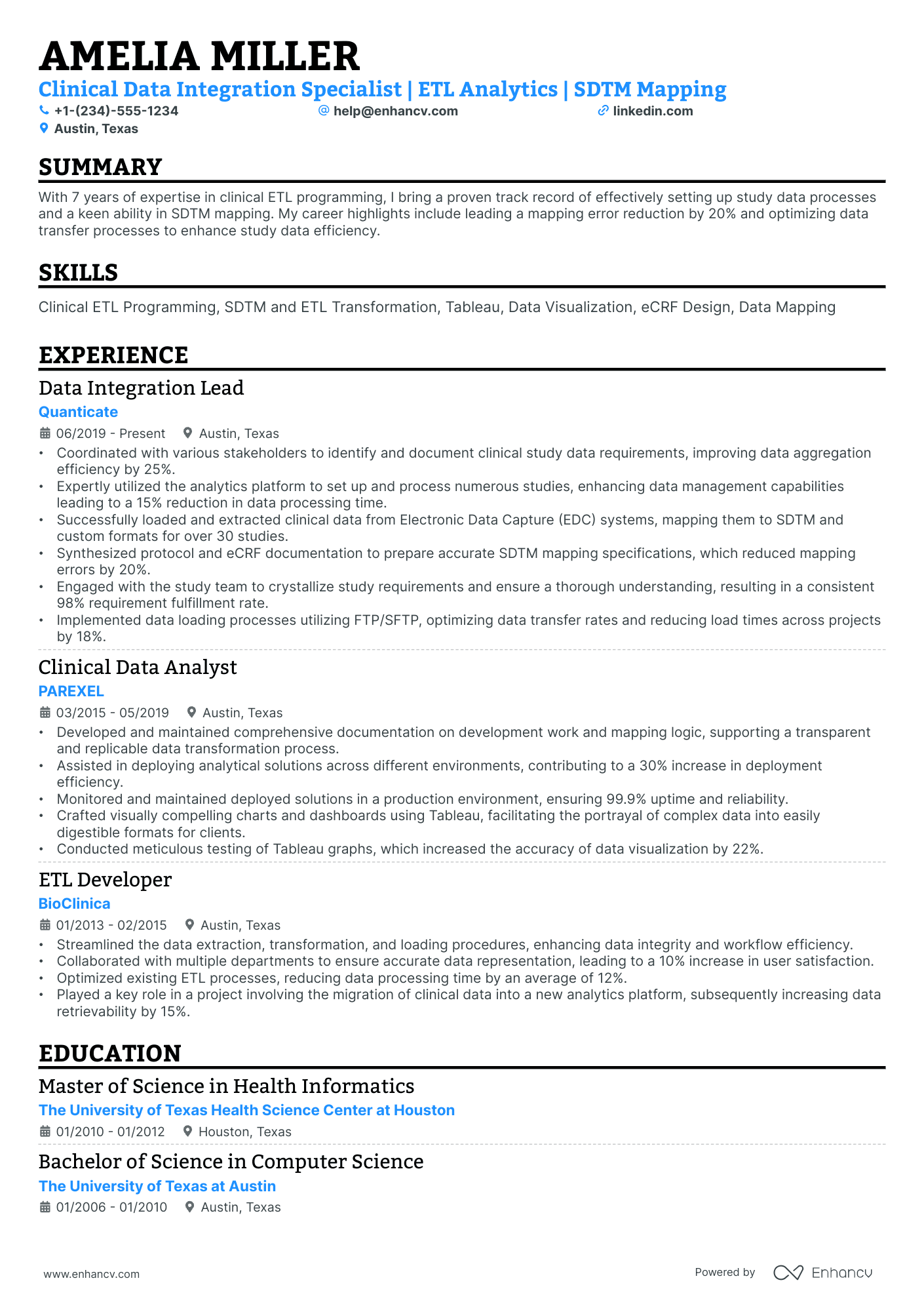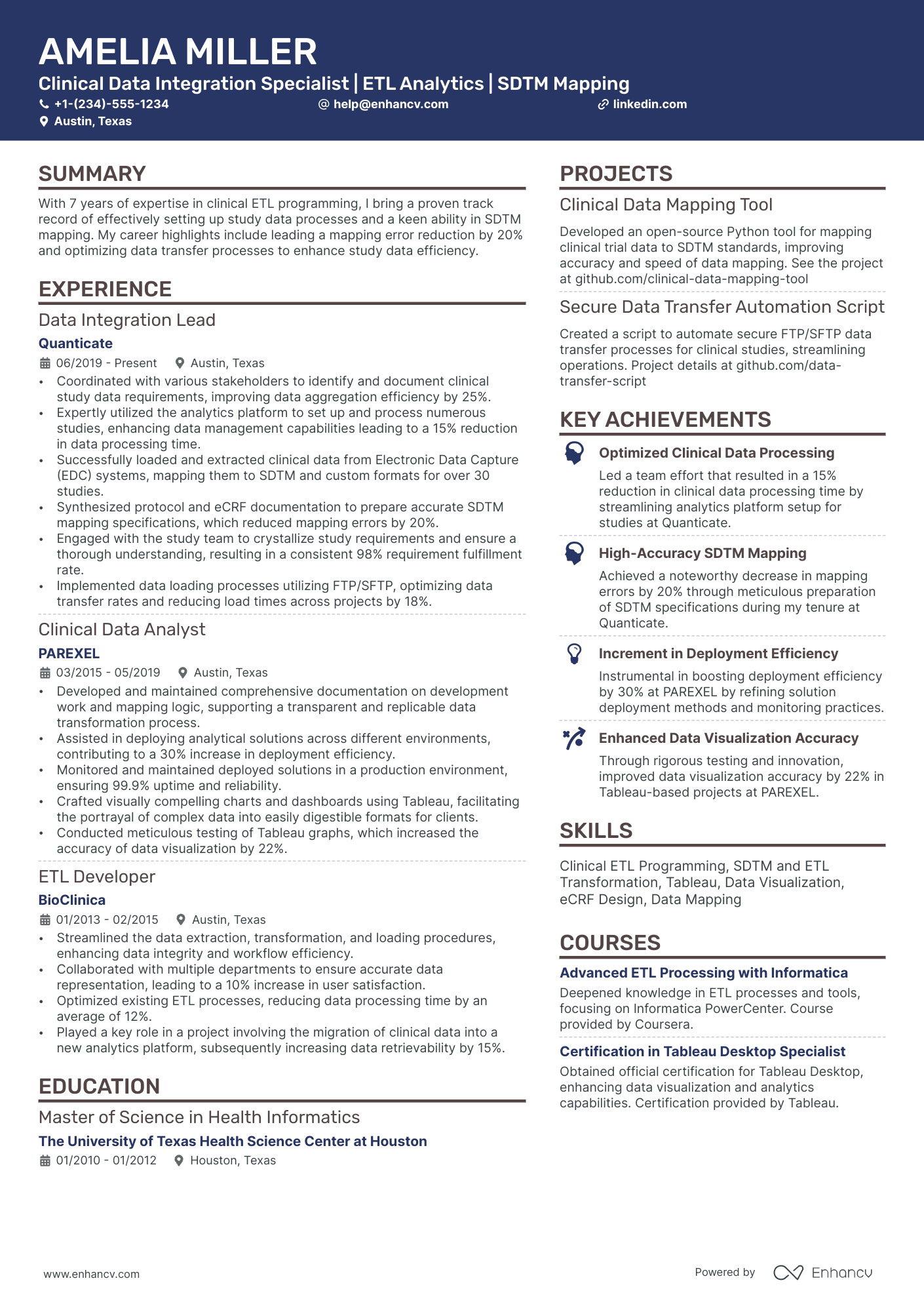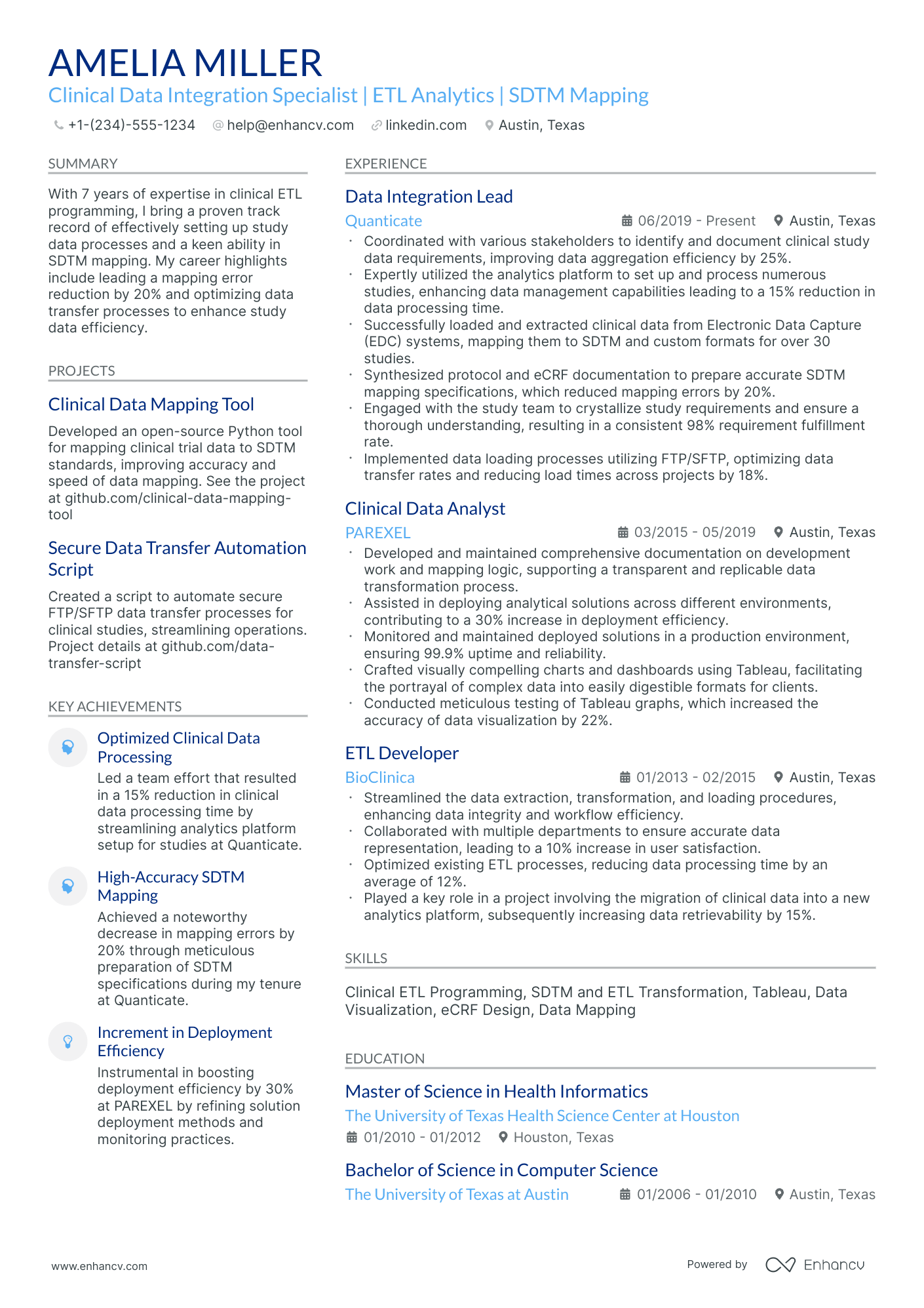One specific resume challenge that you, as a SAS clinical programmer, may encounter is effectively showcasing your proficiency in statistical analysis software while highlighting your impact on clinical trial data management. Our comprehensive guide is crafted to help you fine-tune your resume, ensuring that your unique skills and experiences are clearly communicated and stand out to potential employers.
- The most effective SAS clinical programmer resume samples, reflecting on experience and skills.
- +10 simple, yet impactful methods to tailor your SAS clinical programmer resume to the job advert.
- Using your professional achievements as the North Star to your unique value as a SAS clinical programmer candidate.
- 'No one cares about your education nowadays …' Let's prove this statement wrong with the best-kept industry secrets to your education and certifications.
If the SAS clinical programmer resume isn't the right one for you, take a look at other related guides we have:
- Site Reliability Engineer Resume Example
- L2 Network Engineer Resume Example
- IT Service Delivery Manager Resume Example
- Security Director Resume Example
- Developer Resume Example
- Database Developer Resume Example
- Java Full Stack Developer Resume Example
- Wireless Network Engineer Resume Example
- Statistical Programmer Resume Example
- Service Desk Manager Resume Example
Optimize your SAS clinical programmer resume format to pass the recruiters' assessment
You may be wondering just how much time you need to spend on designing your SAS clinical programmer resume.
What recruiters are looking for is systematised content that is clear and coherent. Thus, your SAS clinical programmer resume needs to answer requirements and why you're the best candidate for the role from the get-go.
Often, a clear layout consists of:
- Sorting your experience in the reverse chronological order - starting with your most recent and relevant roles. This is an excellent choice for more experienced professionals;
- Writing your contact information (e.g. personal phone number and email address) and your portfolio or LinkedIn link in your SAS clinical programmer resume header. If you're wondering to include a photo or not, always make sure that it's appropriate for the country you're applying in;
- Use the basic, most important SAS clinical programmer resume sections - your experience, education, summary, etc. Use your resume's real estate wisely to tell a compelling, professional story and match job description's keywords;
- Don't go overboard with the length of your resume. One page is absolutely fine if you happen to have under a decade of relevant experience.
Are you still wondering if you should submit your SAS clinical programmer resume in PDF or Word format ? The PDF has a few more advantages, as it doesn't change the format and the text can't be altered upon application.
Format matters most when your SAS clinical programmer resume is assessed by the Applicant Tracker System (or the ATS).
The ATS parses resumes, looking for specific keywords, skills or experience that match the job description.
P.S. We recently did a study on how the ATS works and were able to demystify three of the biggest misconceptions about how it assesses candidate resumes.
To pass the ATS evaluation, select any of the serif or sans-serif fonts. Popular choices that would help your SAS clinical programmer resume stand out include Raleway, Exo 2, Montserrat, etc.
Most traditionalists go for Arial or Times New Roman, but it's often the case that many candidates choose these fonts, and you'd thus lose points on the uniqueness front.
Remember, resume layouts can vary by country – for example, a Canadian resume format could look different.
Upload & Check Your Resume
Drop your resume here or choose a file. PDF & DOCX only. Max 2MB file size.
PRO TIP
List your educational qualifications and certifications in reverse chronological order.
The five (plus) definite sections your resume for a SAS clinical programmer job should include are:
- Header with your headline, contact details, and/or a preview of your work
- Summary (or objective) to pinpoint how your success aligns with the role
- Experience with bullets of your most relevant achievements in the field
- Skills to integrate vital job requirements (both technical and personal)
- Your further dedication to the field, showcased via relevant higher education and/or certifications
What recruiters want to see on your resume:
- Proficiency in SAS programming, including BASE SAS, SAS Macros, and SAS/STAT for clinical trial data analysis.
- Understanding of clinical trial processes and relevant regulatory standards such as ICH-GCP, CDISC standards (SDTM, ADaM), and FDA guidelines.
- Experience with creating and validating datasets, tables, figures, and listings (TFLs) for clinical study reports (CSRs).
- Knowledge of database management systems (such as Oracle Clinical, Medidata Rave) and electronic data capture (EDC) for data mining and report generation.
- Strong analytical skills and ability to interpret clinical data, with experience in writing and reviewing statistical analysis plans (SAPs).
Advice for your SAS clinical programmer resume experience section - setting your application apart from other candidates
Your resume experience section needs to balance your tangible workplace achievements with job requirements.
The easiest way to sustain this balance between meeting candidate expectations, while standing out, is to:
- Select really impressive career highlights to detail under each experience and support those with your skills;
- Assess the job advert to define both the basic requirements (which you could answer with more junior roles) and the more advanced requirements - which could play a more prominent role through your experience section;
- Create a separate experience section, if you decide on listing irrelevant experience items. Always curate those via the people or technical skills you've attained that match the current job you're applying for;
- Don't list experience items from a decade ago - as they may no longer be relevant to the industry. That is, unless you're applying for a more senior role: where experience would go to demonstrate your character and ambitions;
- Define how your role has helped make the team, department, or company better. Support this with your skill set and the initial challenge you were able to solve.
Take a look at how real-life SAS clinical programmer professionals have presented their resume experience section - always aiming to demonstrate their success.
- Developed statistical analysis plans and programming specifications using SAS to support multiple phase III clinical trials, resulting in successful FDA submissions.
- Collaborated with cross-functional teams including statisticians, data managers, and clinical study managers to ensure data integrity and quality across studies.
- Accelerated the timelines for data cleaning by implementing macro libraries, reducing the data lock process by 30%.
- Developed and validated SAS programs for the preparation of clinical data reports, ensuring compliance with CDISC standards.
- Mentored junior programmers and provided technical guidance on advanced SAS programming techniques and best practices.
- Streamlined the data review process by designing and generating customized data listings, summary tables, graphs, and derived datasets.
- Automated the creation of complex statistical tables, figures, and listings (TFLs) for the interim and final analyses of clinical data.
- Coded new SAS macros to enhance the efficiency of routine data checks and validations, which were later adopted company-wide.
- Delivered precise statistical analysis outputs for inclusion in Integrated Clinical and Statistical Reports and regulatory documents.
- Led the SAS programming efforts for clinical trial data analysis and reporting for a breakthrough oncology drug research.
- Enhanced team performance by creating a standard operating procedure for SAS program validation that improved program reliability by 25%.
- Initiated a comprehensive review of historical trial data, revealing critical oversight and contributing to the refinement of future trial protocols.
- Contributed to the programming of statistical analysis and data summarization for Phase II clinical trials, adhering to regulatory requirements.
- Collaborated with external CRO teams to ensure alignment with study objectives through precise clinical data management.
- Participated in the development of electronic data capture (EDC) systems, contributing to a 20% increase in the accuracy of real-time data capture.
- Developed innovative programming methods to analyze a diverse array of clinical data, which helped to identify key biomarkers for patient stratification.
- Conducted rigorous data review and validation, achieving an error reduction rate of 15% in clinical study reports.
- Proactively lead the integration of CDISC SDTM and ADaM standards across programming practices, significantly enhancing regulatory compliance.
- Masterminded the SAS programming system for managing complex clinical data sets, resulting in improved data consistency across trials.
- Provided SAS programming support for critical project decisions by efficiently generating interim data analyses for ongoing studies.
- Evaluated and optimized existing SAS programs contributing to a 20% increase in code execution efficiency.
- Instrumental in the development of programming strategies that directly supported the approval of a new cardiovascular medication.
- Spearheaded the creation of a shared macro repository, reducing programming time for standard reports by 35%.
- Designed and executed quality control checks for clinical datasets, effectively maintaining dataset accuracy at 99.9%.
- Efficiently met strict timelines by developing and maintaining SAS programming calendar for deliverables in Phase I and II studies.
- Ensured impeccable data management by resolving queries and discrepancies identified during statistical analysis of trial data.
- Played a pivotal role in programming for ad-hoc requests from the FDA, leading to expedited review times for ongoing clinical trials.
- Applied expert SAS programming skills to facilitate the analysis of clinical trial data, leading to the identification of potential adverse drug reactions.
- Developed a series of highly flexible, reusable programs that enabled the rapid adaptation of analyses in response to changing study designs.
- Collaborated closely with the biostatistics department to ensure the production of high-quality statistical output within tight timelines.
Quantifying impact on your resume
- Detail the number of clinical trial datasets you have successfully prepared and analyzed to emphasize volume-handling capabilities.
- Specify the percentage of time or costs saved through process optimizations or automation you've implemented to showcase efficiency gains.
- Mention the number of regulatory submissions you've contributed to, such as NDAs or BLAs, to highlight your direct impact on company milestones.
- Quantify the scale of data you've worked with, in terms of patients or variables, to demonstrate your ability to manage large datasets.
- Include the number of statistical reports you've generated, to illustrate productivity and experience with output deliverables.
- Indicate the reduction in error rates achieved through your validation work to show your commitment to accuracy.
- Report the number of programming languages and software tools you're proficient in to present a broad technical skill set.
- List the number of cross-functional teams you've collaborated with, to display teamwork and interdisciplinary communication skills.
Action verbs for your SAS clinical programmer resume
What if you don't have any experience?
There are two very common scenarios about candidates with less experience. They are either:
- Fresh out of college in search of a SAS clinical programmer role
- Transferring over from a completely different field
Both of these types of candidates still have a shot at landing their first job in the industry.
All they need to do about the experience section of their SAS clinical programmer resume is:
- Consider their strengths - would the outcomes of their previous roles or niche skill sets impress recruiters? Feature those towards the top of your resume
- Exclude any and all irrelevant experience items - remember that at the end of the day, you're telling a story that aims to align with the ideal candidate for the SAS clinical programmer job
- Win recruiters over with personality - perhaps your ambition, dreams, and diligence would make you the perfect fit for the SAS clinical programmer role. Dedicate resume space to detail your personality traits by showcasing how they've helped you succeed in past roles
- Tailor your experience to specific job requirements - ensure your SAS clinical programmer resume answers the advert in the best way possible.
Recommended reads:
PRO TIP
If the certificate you've obtained is especially vital for the industry or company, include it as part of your name within the resume headline.
SAS clinical programmer skills and achievements section: must-have hard and soft skills
A key principle for your SAS clinical programmer resume is to prominently feature your hard skills, or the technologies you excel in, within the skills section. Aim to list several hard skills that are in line with the job's requirements.
When it comes to soft skills, like interpersonal communication abilities and talents, they're trickier to quantify.
Claiming to be a good communicator is one thing, but how can you substantiate this claim?
Consider creating a dedicated "Strengths" or "Achievements" section. Here, you can describe how specific soft skills (such as leadership, negotiation, problem-solving) have led to concrete achievements.
Your SAS clinical programmer resume should reflect a balanced combination of both hard and soft skills, just as job requirements often do.
Top skills for your SAS clinical programmer resume:
SAS Programming
SQL
Clinical Trial Data Management
CDISC Standards (SDTM, ADaM)
Statistical Analysis
Data Visualization Tools (e.g., SAS Visual Analytics)
Data Cleaning and Validation Techniques
Electronic Data Capture (EDC) Systems
Programming in R or Python
Regulatory Compliance (FDA, EMA)
Attention to Detail
Problem-Solving
Communication
Team Collaboration
Time Management
Adaptability
Analytical Thinking
Critical Thinking
Organizational Skills
Interpersonal Skills
PRO TIP
The more time and effort you've put into obtaining the relevant certificate, the closer to the top it should be listed. This is especially important for more senior roles and if the company you're applying for is more forward-facing.
What are the best certificates to add to your SAS clinical programmer resume + how to curate your education section
The education and certification resume sections are the underdogs of your SAS clinical programmer resume.
They showcase to recruiters that you've invested plenty of time to gain valuable and specific know-how, vital for growth.
As far as the resume education section is concerned:
- Detail only advanced education, specifying the institution and timeframe.
- Indicate your forthcoming graduation date if you're in the midst of your studies.
- Consider omitting degrees that don't align with the job's requirements.
- Offer a description of your academic journey if it underscores your notable achievements.
When curating your degrees and certificates on your SAS clinical programmer resume:
- Select only accreditation that matters to the role
- Niche knowledge that could help you stand out as a candidate (as is within the past few years), should be listed towards the top of your resume
- Include any pertinent data for credibility (e.g. institute name, graduation dates, etc.)
- Irrelevant degrees and certifications shouldn't make it on your resume. Those include your high school diploma and any specializations that have nothing to do with the technical or soft skills that are required for the job
As a final note, if you feel tempted to exclude your education or certification from your resume, don't.
These two sections could help you have a better competitive edge over other candidates - hinting that your professional journey in the industry may be for a longer period of time.
Recruiters find all of these SAS clinical programmer credentials impressive:
The top 5 certifications for your SAS clinical programmer resume:
- Certified Clinical Data Manager (CCDM) - Society for Clinical Data Management (SCDM)
- SAS Certified Clinical Trials Programmer Using SAS 9 (SAS Clinicals) - SAS Institute Inc.
- SAS Certified Base Programmer for SAS 9 (Base SAS) - SAS Institute Inc.
- SAS Certified Advanced Programmer for SAS 9 (Advanced SAS) - SAS Institute Inc.
- Professional in Healthcare Information and Management Systems (CPHIMS) - Healthcare Information and Management Systems Society (HIMSS)
PRO TIP
The more trusted the organization you've attained your certificate (or degree) from, the more credible your skill set would be.
Recommended reads:
Choosing between a SAS clinical programmer resume summary or objective
Many may argue that, in recent times, the SAS clinical programmer resume summary or objective has become completely obsolete.
But the reality is different as both of these resume sections provide you with an opportunity to :
- integrate SAS clinical programmer-vital keywords
- showcase your accomplishments
- answer why you're applying for this particular role.
The difference (between the summary and the objective) is that the:
- Resume objective puts your career goals in a more prominent position.
- Resume summary focuses more on career milestones.
We recommend you select the summary if you happen to have plenty of experience you'd like to spotlight from the very start of your SAS clinical programmer resume.
Meanwhile, the objective is ideal for those candidates who'd like to further prove their suitability for the role with their goals and soft skills.
We've featured some industry professional SAS clinical programmer resume samples to the best resume summary and objective structures:
Resume summaries for a SAS clinical programmer job
- Accomplished SAS clinical programmer with over 7 years of experience in data analysis and management within the pharmaceutical sector. Proficient in CDISC standards, adept at streamlining data workflows, and carrying a track record of reducing data processing time by 30% in a major clinical trial.
- Dynamic professional with a background in biomedical research and 2 years' specialization in SAS programming. Expertise encompasses data mining, statistical analysis, and creating visual data presentations, leading to the publication of two research articles in peer-reviewed medical journals.
- Former database administrator with 10 years of IT experience transitioning to SAS Clinical Programming. Proven skills in managing complex databases and a high proficiency in SQL and Python, pursuing a shift to apply technical knowledge within clinical data analysis to impact patient health outcomes.
- IT Project Manager eager to transfer 8 years of project leadership and system development experience into a fulfilling career in SAS Clinical Programming. With strong analytical skills and a master's degree in computer science, committed to mastering clinical trial data management and statistical programming.
- Eager to launch a career in SAS Clinical Programming, bringing a fresh perspective and relentless commitment to mastering analytical techniques. With a recent bachelor's degree in statistics and a certification in SAS Base Programming, aiming to contribute to high-quality clinical data analysis from the ground up.
- As a recent graduate with a Master of Science in Health Informatics, I am dedicated to starting my professional journey as a proficient SAS clinical programmer. Keen on utilizing my academic foundation, I aim to develop innovative data solutions that optimize clinical trial efficiency and enhance patient care.
Optimize your resume summary and objective for ATS
Drop your resume here or choose a file.
PDF & DOCX only. Max 2MB file size.
Extra SAS clinical programmer resume sections and elements
Creating a winning SAS clinical programmer resume isn't about following a rigid formula. The key is to tailor it to the job requirements while maintaining your unique personality.
Consider including these additional resume sections to enhance your profile:
- Awards - Highlight industry-specific awards as well as any personal accolades to demonstrate recognition of your expertise and achievements;
- Hobbies and interests - Share your interests outside of work. This can provide insights into your personality and indicate whether you'd be a good cultural fit for the organization;
- Projects - Detail significant projects you've been involved in, focusing on your contributions and the outcomes;
- Publications - If you've authored or co-authored academic papers or other publications, include them to establish your credibility and in-depth knowledge of the field.
These sections can give a more comprehensive view of your capabilities and character, complementing the standard resume content.
Key takeaways
At the end of our guide, we'd like to remind you to:
- Invest in a simple, modern resume design that is ATS friendly and keeps your experience organized and legible;
- Avoid just listing your responsibilities in your experience section, but rather focus on quantifiable achievements;
- Always select resume sections that are relevant to the role and can answer job requirements. Sometimes your volunteering experience could bring more value than irrelevant work experience;
- Balance your technical background with your personality traits across various sections of your resume to hint at how much time employers would have to invest in training you and if your profile would be a good cultural fit to the organization;
- Include your academic background (in the form of your relevant higher education degrees and certifications) to show recruiters that you have the technical basics of the industry covered.
